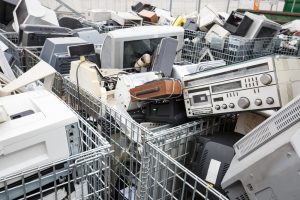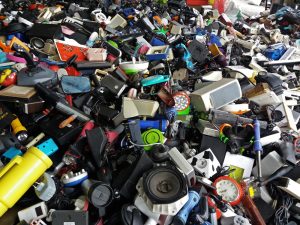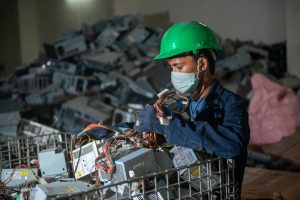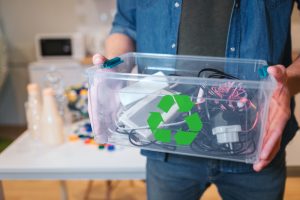
Picture this, just in 2021the United States has generated over 50 million metric tons of e-waste. That’s not the total amount of waste, that’s just electronic waste. The amount of discarded computers, printers, home appliances, and medical devices that we throw out annually is equal to the weight of 350,000 Statues of Liberty.
What’s even more concerning is that most of the e-waste and its upcycling potential is lost. Most of the electronic waste is either incinerated or placed in landfills, not only adding to the issue of depleting finite resources but causing pollution and hazards for our health.
So let’s look at what e-waste is, how big of a problem it is, and what we can do to manage e-waste more effectively and sustainably.

E-waste is the electronic product we discard after its useful life has ended (and occasionally when it’s not as modern as we desire). This waste category encompasses all possible electrically-charged appliances and devices, along with the peripheral and auxiliary equipment that help them run (computer mice, chargers, keyboards, etc.)
E-waste is predominantly made of plastic and metal but also can include some heavy metal elements such as printed circuit boards, or others like refrigerants in fridges and air conditioners. Both the heavy metals and the cooling chemicals have significant harmful effects on the environment when not disposed of properly.
More on that later. Let’s look at what other categories e-waste can fall under.

In the United States, the governmental body that classifies, regulates, and aids businesses and private citizens with their e-waste disposal is the Environmental Protection Agency (EPA). According to EPA, electronic waste can be any of the following:
These can be, for example, refrigerators, air conditioners, washing machines, and others.
They can be microwaves, rice cookers, electric kettles, food processors and blenders, toaster ovens, vacuum cleaners, and more.
These include laptops, tablets, desktop computers, mobile phones, printers, modems, monitors, keyboards, computer mice, docking stations, hard disk drives, batteries and chargers, and more.
Like drills, eclectic hammers, and other DIY or construction equipment

There will be over 347 million tons of unrecycled e-waste, globally in 2022. E-waste is the fastest-growing waste stream on the planet. Its harmful effects are very impactful due to our fast-paced technological development, the heightened market competitiveness, the affordability of various IT products and smart home appliances, and also the shortened lifespan of some electronic devices.
The problem with e-waste is further exacerbated by the growth of the world population and the improved economic prosperity, that is reaching more people. All these factors drive the accumulation of e-waste upwards with unprecedented acceleration, urging us to look at the issue closely.
What are the effects of the rapid growth of e-waste?
Let’s look at what the data is showing.
As reported by the Green Citizen a single computer screen contains somewhere between 5 and 8 pounds of lead. Currently, 40% of the lead found in our landfills comes from electronic devices. And that is just one type of e-waste element that contains heavy metal.
With lead being one of the most harmful toxins for the human body, it’s frightening how much of it is left untreated or incinerated at garbage management sites, leading to leaks into our atmosphere, soil, and water resources.
The contamination with heavy metals (and lead is just one of them) ends up poisoning our atmosphere, sea life, land flora, and fauna. We’re not only directly threatening the well-being of other life on the planet but contaminating our food and water sources.
In addition to the serious health and environmental hazard, the lack of appropriate recycling processes for e-waste creates acute economic issues.
Every electronic device simply laying in landfills is a waste of valuable resources. Many of our electronic devices contain scarce and precious metals that are needed for our continued technological development.
As covered by the Guardian in 2019, e-waste contained copper, gold, silver, iron, and platinum, equivalent to $57 billion. Unfortunately, most of these metals were dumped or burned rather than recycled.
Furthermore, the Globe and Mail, reports that the world’s precious metals e-waste recovery market will grow from $9.22 billion in 2021 to $9.61 billion in 2022. That’s a compound annual growth rate (CAGR) of 4.28%.
It’s abundantly clear that e-Waste poses a significant threat to our sustainable future and we need to actively engage in finding appropriate e-Waste management solutions that work in the long run.

E-waste management involves the processes of collecting, recovering, and recycling electronic equipment, devices, and appliances. Currently, in the United States, e-waste management practices involve domestic landfill dumping, international shipments of domestically produced e-waste, along with some recycling and reuse programs. The EPA estimates that in 2019, the United States disposed of roughly 7 million tons of e-waste. Only 15% of that waste was recycled.
We need a complete change in the way we think about electronic devices that no longer serve us. Electronic devices are a valuable source of raw materials, most of which are hard to find and process. An outdated smartphone or computer can be the raw materials from which we produce new devices.
Modern day e-waste management systems are heavily concerned with the safe methods of disposal of unfit units (their disassembly and destruction) as well as finding more sustainable methods of upcycling elements or entire constructions of electronic devices. And that makes e-Waste management a necessary discipline requiring a collective effort.
Of the 13 million tons of e-waste produced last year in the USA, less than 2 million tons were recycled. It’s evident not enough of our discarded electronics are reused.
When done properly recycling can reduce the leakage of toxic materials into the environment and spare further spending on our depleting natural resources. The practice needs to be more widely adopted.

First, let’s look at some of the e-waste elements that can be recycled. There are several major e-waste recycling categories:
Once collected by a waste management company, the e-waste devices are disassembled in a safe human environment and each element is either recycled or further transported to a recycling facility specializing in the appropriate recycling category.

Plastic and metal (plastic and aluminum elements from hard disks, toner, and ink cartridges ) from the e-waste are recycled in regular recycling facilities since they don’t require further processing to make them safe to handle.
Glass elements, most of which are extracted from computer monitors and TVs contain several hazardous substances that require their recycling to be performed in specialized facilities, ensuring these components are safely disassembled and treated so none of the dangerous heavy metals end up in the environment.
E-waste elements that contain mercury are recycled in facilities with technology that can eliminate it safely and turn it into products like dental amalgams, fluorescent lighting, and metric instruments.
The circuit boards are upcycled in facilities that specialize in smelting materials like
gold, silver, palladium, copper, tin, and other valuable metals.
Batteries are probably the most complicated and time-consuming to recycle. They require specialized recycling that recovers the nickel, cobalt, cadmium, and steel they contain to be used again in new batteries. Leaving batteries to decompose at landfills is dangerous-they should always be discarded and recycled.
Now that we’ve covered what e-Waste is and how it needs to be recycled, let’s look at some of the best e-Waste management practices that will offer a sustainable future for our out-of-date electronics.

There is a certain relief in knowing that every piece of garbage we produce has a continued life once we discard it, e-Waste included. But making sure no battery goes in the same bin as your food scraps starts with personal responsibility and grows into a collective conscientiousness.
While we keep pushing for more effective e-Waste management practices, let’s look at what some of the ideas of sustainable e-Waste recovery are, and what we can personally do to decrease our harmful contribution.
In a fast-consuming world, we often get lost in the latest trends and technologies, forgetting that our old smartphone or laptop is still very much functional. What you can do is delay upgrading your products for as long as possible. If it isn’t broken, don’t change it. Your small compromise will minimize e-waste and any further adverse effects on the planet.
While this saying usually has a negative connotation, here it can mean something good. When purchasing any new electronic devices you can make sure you choose these products that are designed to be repaired, upgraded, and refurbished- living multiple lives and enabling a more circular economy.
A third option you can consider when replacing your e-devices is a donation. Instead of adding to the e-Waste problem you can consider selling, or passing on your old but working electronic appliance to someone who might find it useful. Pass the torch, and decrease your impact on the environment.
Lastly, you should learn more about the recycling practice of your local municipality or district. You might be very diligent with separating and categorizing your recycling, but not knowing where it goes once it leaves your home or office makes your efforts fruitless. Investigate how and where the components of your e-devices are recycled, and whether that is done safely and responsibly.

The fast development of technology and our consumption-driven society create an acute e-waste problem. Currently, we produce way-more electronic devices than we’re able to recycle. That, unfortunately, leads to the accumulation of vast amounts of e-waste left to decompose at landfills and threaten our entire ecosystem.
Recycling e-devices is a serious concern we’ve briefed through in this article, hoping to raise more awareness and prompt you to be an active participant in finding a sustainable solution.